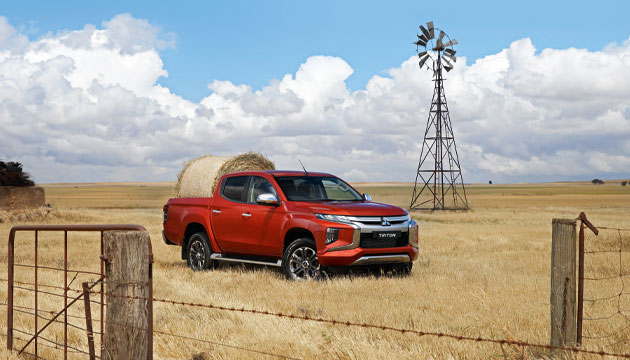Mitsubishi’s latest Triton takes on a new face.
Story Bruce McMahon
The Mitsubishi Triton utility is one of the quiet achievers on the Australian vehicle market. Overshadowed to some extent by the Ford Ranger ute and the new-age sophistication of newcomers such as Volkswagen’s Amarok, the Triton remains popular with everyone from farmers to fishers. The Mitsubishi is often among the top 10 sellers across the board, passenger cars included, sitting in behind the Toyota HiLux and Ranger on the charts.
Forty years ago, the first iteration of the Triton was badged here as the Chrysler D-50. In 1980 it became the petrol-engined, two-wheel-drive Mitsubishi L200 with four-wheel drive versions arriving a year later. These became Tritons in 1986.
While early versions of these Mitsubishis were more workhorse than playmate, the range expanded to today’s line-up, which runs from basic two-wheel-drive ute to fancy 4WD machines with an array of modern convenience, comfort and safety features. Although cheaper than some, the Mitsubishis lack little.
Today’s Tritons run with three body styles – single cab, club cab and dual cab – plus two- or four-wheel drive, manual or automatic transmissions. All have been revised for 2019, although in Australia the focus remains on four-door, 4WD versions.
This latest Triton is hard to miss in the bush or on the beach, with a bold, fresh face. While there has been some tinkering with rear leaf springs, plus the addition of a new off-road mode selector for premium models and some interior upgrades, the only mechanical change is a six-speed auto option for the diesel engine.
Mitsubishi calls the new look the latest generation of their Dynamic Shield Concept, which is a front-end style used on other Mitsubishi models. According to the brand, the use of more chrome pieces on the grille gives a “high-rigidity look” and the vertical arrangement “gives expression to a sense of the occupants being embraced firmly and safely”. This imposing look can be polarising – to some it is too heavy-handed – although it does mean a small improvement in the approach angle for 4WD models.
Also better this time is the four-door Triton’s ride comfort. Tweaks to the rear suspension bring extra control and a little less lumpiness over rough and ragged roads. Front suspension and steering remain as before and the double cab model’s 11.8-metre turning circle and 3.8 turns lock-to-lock are appreciated when parking a vehicle just over 5m long.
The Triton’s four-cylinder, 2.4-litre diesel engine produces 133kW at 3500rpm and 430Nm of torque at 2500rpm, all delivered with a linear smoothness through the new six-speed automatic under throttle. There is a slight hesitation to the drive train if asked for sudden acceleration on a light throttle, and the likes of the Ford Ranger – with 147kW and 470Nm – deliver a touch more power and torque a fraction earlier.
The Triton is relatively quiet and refined for a commercial vehicle. Interior space and comfort levels are good, while the back seats, with more incline than some rivals, are among the best around for full-sized adults. There is the usual USB ports and Bluetooth connectivity, but some of the touchscreen controls – such as those for audio – can be annoying.
Among safety features are cameras and radars to detect vehicles or people ahead, blind-spot warnings and lane-change assist to avoid venturing into the path of a vehicle or tree, and rear traffic alert checks for cars, pedestrians or animals. To help with off-roading, top-of-the-range 4WD versions have a mode selector for gravel and mud or snow, sand and rock surfaces.
Well proven over 40 years is the Mitsubishi Triton’s value for money compared to rival utes. Today’s range runs from $22,490 for a basic 2WD Triton through to $51,990 recommended retail for a 4WD GLS Premium Double Cab with all the gear.
This story excerpt is from Issue #125
Outback Magazine: June/July 2019









